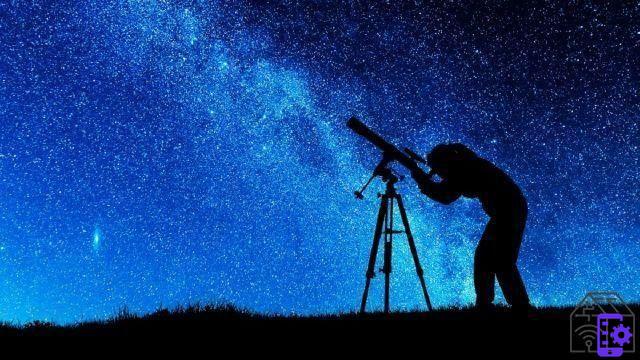
If you have found a quite dark place (an isolated hill, a deserted beach) and on a clear night you have looked up, you were bewitched. Stars, planets, galaxies: lights from other worlds have traveled billions of kilometers to be admired by you. And now you want to do more: find the right tool to look at the immensity of the celestial vault a little more closely. So we give you a hand in choosing the one that's right for you and list some of the best telescopes you can buy in 2021.
The best telescopes of 2021 for stargazing
Before figuring out which are the best telescopes you can buy in 2021, we thought we'd summarize which ones are most important features of a good telescope and what are the main types of this tool. After that we will list the telescopes in order of price, also talking about what you can expect to find in the various price ranges. This helps the less experienced to understand what to look for: if you already know the topic jump directly to the product selections from the menu (top left of the page).
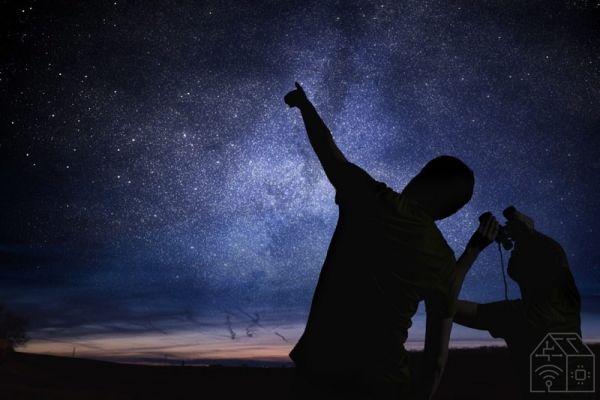
What are the most important features for a telescope?
There are many variables to consider for professional and high-level telescopes. But for those who want to look at the stars as a simple enthusiast, we can summarize the main features.
- Main lens diameter. Whether it's a lens or a mirror (more on that later), the width of your telescope's lens determines how much light it can absorb. And therefore the ability to observe smaller and less luminous objects. Telescopes up to 4-5 inches (from 100 to 125 mm approximately) can be good for seeing our Moon up close, the planets and moons of Jupiter. Larger diameters also allow us to observe clusters, galaxies and nebulae further away in the sky.
- The size and weight. The second factor to keep in mind is: how big is your dream telescope? If you live in the city center and need to travel to find the dark sky, a smaller telescope might be the best solution, even at the expense of the diameter of the lens. If, on the other hand, you want to buy it for your isolated house in the mountains, you can also exaggerate with the dimensions.
- The maximum magnification. Telescopes are used to magnify huge but distant objects. But a 200X zoom on a small lens may show you a very grainy image. So take this aspect into consideration when buying: magnification is important but not the first feature.
- The frame. There are of your kinds. The simplest is that altazimutale, which allows you to move the telescope horizontally and vertically. Great for stable viewing and analyzing a precise piece of sky. The frame equatorial instead it allows to compensate for the Earth's rotation and to follow the (relative) motion of the stars in the night sky. If you want to carry out astrophotography is a must: allows you to follow the celestial body long enough to absorb a large amount of light. Finally, there are also the computerized frames, perfect for searching for a celestial body using the internet. But they usually cost a lot more.

Types of telescope
There are two main categories of telescope, plus a hybrid category between the two. I'm:
- Refractory telescopes. They consist of a long, narrow tube that has a lens at the end. To increase the lens diameter you need to increase the length of the telescope. They have excellent contrast and do not require great maintenance: just keep the lens and the eyepiece on which you rest your eye clean. When the diameter is increased, the cost rises rapidly.
- Reflector telescopes. The focus of the light rays occurs through a concave mirror, placed on the bottom of the instrument, which then reflects on a second mirror which sends the light to the eyepiece. Can maintain a lower cost even by enlarging the diameter: without spending a lot you will be able to see distant galaxies. But it needs more maintenance and cleaning as the tube is open.
- Finally, there are the catadioptric or Cassegrain telescopes. They have a large aperture lens (the corrector) and a series of mirrors to focus the image, merging the two methods already seen. They tend to cost a little more than reflectors but offer many advantages: they are more compact than refractors and need less maintenance than reflectors. So you can carry them with ease.
All three products have the ability to show you great images of the night sky, it depends on what you are looking for. And how much are you willing to spend.
How much to spend on a good telescope
The price is a fundamental component of the products, there is no need to say "I want the best". Because it depends on your needs: if you take a laptop with an extraordinary video card but you only play in the meadow and use Word, you are wasting it. Likewise, taking the best telescope in the world to "find out" if your child is interested in astronomy is a risky choice. Better maybe a least expensive product to upgrade later: you can use the least expensive telescope to watch the moon on vacation, leaving the best product at home.

In general, spending less than 100 euros you will have products of rather low quality. But that may be enough to observe our Moon and the closest planets, even if not at their best. THEAround 200 euros you will find products for beginners which, however, have what it takes to give you satisfaction. To the 400 €, started to find products of excellent quality. Beyond that, you find computerized frames and superior quality, but the price goes up very quickly.
The best telescopes of 2021: around 100 euros
Under 100 euros it is difficult to find truly remarkable telescopes, so much so that many good binoculars could reserve better views of the night sky. But with a 60mm diameter and 700mm focal length, the Telmu GS70060 it's a good one refractor. It has an optical viewfinder to find the area of sky to look at and a smartphone adapter for a few shots or to use the sky exploration apps. A product that is good for the little ones or for those who are just starting out, for look at the moon and the planets. Especially given the price.
Going up in price you will find the Celetron Travelscope 70. One of the most established brands in the commercial telescope industry, offering this extremely portable product. With a diameter of 70 mm and a focal length of 400mm, this refractor can be easily adjusted with the altazimuth mount on the tripod. You can zoom up to 20x or 40x with the two eyepieces, with decent quality. A quality product to get started and which can also be useful later on when traveling. If you want to admire our closest planets and a good starting point.
Discount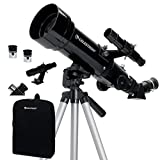 Celestron Travelscope 70 - Portable Telescope, Refractor ...
Celestron Travelscope 70 - Portable Telescope, Refractor ...
- 70mm refractor telescope with fully coated glass optics and lightweight frame
- Custom backpack included for convenient storage of your telescope and accessories
- See in no time with a quick and easy setup, without tools
The best mid-range telescopes 2021
Going over 200 euros, we find a pair of similarly priced reflector telescopes from two well-known brands. On the one hand we have it Sky-Watcher Newton 114/900 EQ1, with a lens of 114 millimeters and an optical tube length of 900mm. This Newtonian reflector allows you to see the planets well but also to start observing even the most distant celestial bodies. It has the equatorial mount and it can be useful for those who want to dabble in astrophotography.
Discount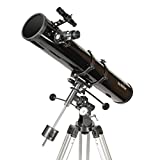 Sky-Watcher Newton Telescope 114/900, Equatorial Mount ...
Sky-Watcher Newton Telescope 114/900, Equatorial Mount ...
- Optical scheme: Newton reflector
- Focal Length: 900mm
- Opening: 114mm
Seben Big Boss 1400-150 EQ3 has a larger diameter, from 150 millimeters. A large focal length of 1400mm and good magnification capacity with the two eyepieces. Also in this case we find a product with equatorial Mount, so astrophotography is possible. You will struggle to see distant galaxies but it is a good start, without spending too much.
 Seben Big Boss 1400-150 EQ3 Telescope Reflector Astronomy ...
Seben Big Boss 1400-150 EQ3 Telescope Reflector Astronomy ...
- Visual magnitude: visible up to 13,8M! (approx.5.650.000 stars visible!)
- Mirror diameter: 150mm
- Focal distance: 1400mm (reflex reflector system)
Touching the 300 euros you can find the Celestron 822025 Telescopio 130EQ, with a wide lens 130 millimeters and a length of 650mm. The equatorial mount makes it suitable for photographs and the image quality is very good indeed. With the smartphone app you can find many celestial bodies to study and admire.
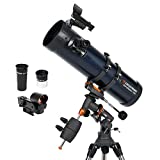 Celestron 822025 Telescopio 130EQ
Celestron 822025 Telescopio 130EQ
- Typology: Reflector
- Mount: Equatorial
- Diameter: 130 mm
High band
If you want a great product while raising the price a little, the Dobsonian telescope Orion SkyQuest XT6 Classic it might be the best solution. With a diameter of 152 mm and great stability thanks to the base Dobson, you can also see more distant celestial bodies if you are in a particularly dark area. With the mount Altazimutale, is not suitable for photography but can give you breathtaking views.
 Orion SkyQuest XT6 Classic Dobsonian Telescope
Orion SkyQuest XT6 Classic Dobsonian Telescope
- It is possible for a beginner to use a 60mm telescope for a couple of months or years before deciding to switch ...
- Simple navigation and no need for polar alignment make this Dobsonian reflector telescope ...
- The parabolic mirror f / 8 with a diameter of 152 mm is fantastic for lunar and planetary observations, and the brightness ...
Finally, if you have no spending limits, Celestron NexStar 6SE has a diameter of 152 millimeters and focal length of 1500 mm. But the difference is there SkyAlign function, which orients the telescope for you to find the celestial bodies you want to look at. And you will see them very well, thanks to the well-made optics of this telescope. The only problem is the price, not exactly as an amateur.
 Celestron NexStar 6SE Computerized Telescope
Celestron NexStar 6SE Computerized Telescope
- Schmidt–Cassegrain telescope
- Diameter: 152 mm
- Focal Length: 1500 mm
With all these telescopes to choose from, you can enjoy the night sky to the fullest. But remember that more important than any tool is finding the right place. Darkness is your ally when you look at the stars. So find the right place and look up: in front of you you have the whole universe to take a look at.




















![[Review] Samsung Powerbot VR7000: the robot vacuum cleaner from Star Wars](/images/posts/6bc44de38605b5c0fa12661febb1f8af-0.jpg)





